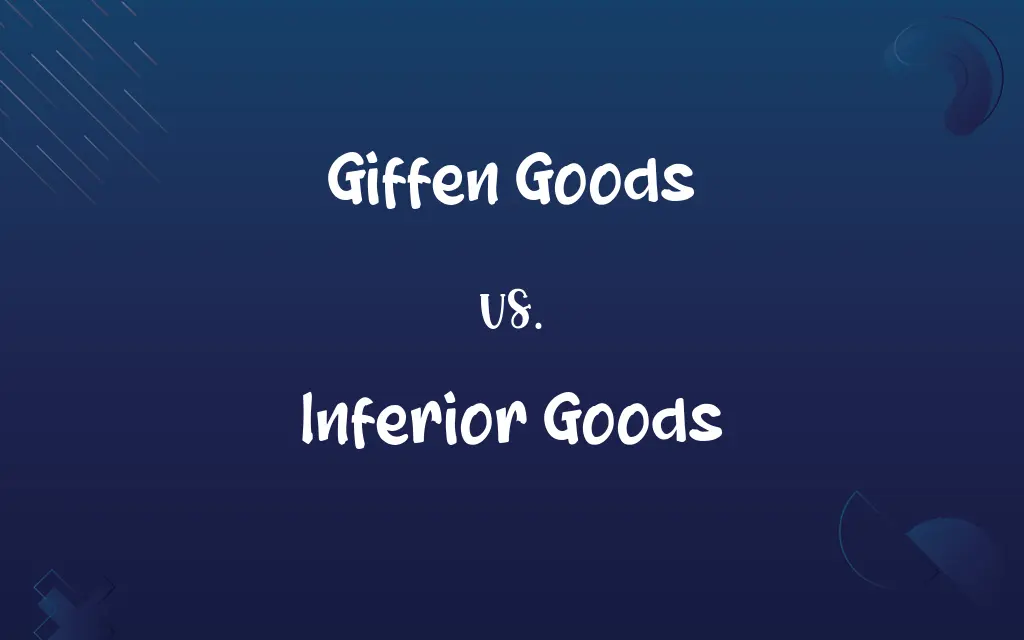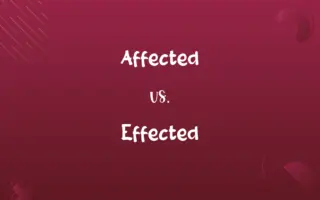Giffen Goods vs. Inferior Goods: Know the Difference

By Shumaila Saeed || Published on January 13, 2024
Giffen Goods are a rare economic anomaly where demand increases as price increases, often due to the absence of cheaper alternatives, while Inferior Goods are those whose demand decreases as consumer income rises, replaced by more desirable alternatives.

Key Differences
Giffen Goods and Inferior Goods both react uniquely to changes in consumer income and price. Giffen Goods are exceptional cases where demand increases with rising prices, often due to the lack of substitutes. This phenomenon contradicts the typical law of demand. Inferior Goods, on the other hand, see decreased demand as consumer income increases, as they are typically replaced by superior alternatives.
Shumaila Saeed
Jan 13, 2024
The essence of Giffen Goods lies in their counterintuitive demand curve. They are usually staple commodities, such as basic food items, where an increase in price leads to consumers spending a larger portion of their income on these goods, reducing their ability to purchase more desirable alternatives. Inferior Goods, in contrast, are not necessarily of lower quality, but are perceived as less desirable due to lower income levels. As income grows, the demand for these goods falls, as consumers opt for higher-quality substitutes.
Shumaila Saeed
Jan 13, 2024
The rarity of Giffen Goods is noteworthy; they are exceptions in the economic world. Their demand increases even as their prices rise, often due to a strong dependence on the product and lack of alternatives. Inferior Goods, common in various markets, are budget-friendly options that lose their appeal as consumers' purchasing power improves.
Shumaila Saeed
Jan 13, 2024
Giffen Goods often play a crucial role in economies with lower-income groups, where rising prices can lead to a paradoxical increase in consumption due to the essential nature of the product. Inferior Goods, while not necessarily essential, serve as a practical choice for consumers with limited income, such as off-brand groceries or budget clothing.
Shumaila Saeed
Jan 13, 2024
The identification of Giffen Goods requires a keen understanding of consumer behavior and market dynamics, as they defy conventional economic logic. Inferior Goods, however, are identified through changes in income and consumption patterns, reflecting the shifts in consumer preferences as economic circumstances evolve.
Shumaila Saeed
Jan 13, 2024
ADVERTISEMENT
Comparison Chart
Demand vs. Price
Demand increases as price increases
Demand decreases as price increases
Shumaila Saeed
Jan 13, 2024
Relation with Income
Often bought out of necessity, not directly related to income changes
Demand decreases as consumer income increases
Shumaila Saeed
Jan 13, 2024
Nature of Goods
Essential, staple items with no close substitutes
Non-essential, often replaced by superior alternatives
Shumaila Saeed
Jan 13, 2024
Market Rarity
Extremely rare, exceptional cases in economics
Common in various markets, especially at lower income levels
Shumaila Saeed
Jan 13, 2024
Consumer Perception
Purchased more out of necessity than choice
Viewed as less desirable, often due to lower quality or prestige
Shumaila Saeed
Jan 13, 2024
ADVERTISEMENT
Giffen Goods and Inferior Goods Definitions
Giffen Goods
Giffen Goods are products that see an increase in demand when their prices rise, defying standard economic logic.
Despite the rise in rice prices, its demand increased, demonstrating its status as a Giffen Good.
Shumaila Saeed
Dec 17, 2023
Inferior Goods
Inferior Goods are products whose demand decreases as consumer income increases, often replaced by superior alternatives.
As her salary increased, Jane stopped buying generic brands, showcasing their nature as Inferior Goods.
Shumaila Saeed
Dec 17, 2023
Giffen Goods
Giffen Goods are often essential items with no close substitutes, leading to higher consumption as prices increase.
When bread prices soared, it became a Giffen Good as people bought more of it instead of more expensive food items.
Shumaila Saeed
Dec 17, 2023
Inferior Goods
Inferior Goods are not necessarily low in quality but are perceived as less desirable due to their association with lower income.
The decline in public transport usage with rising incomes highlights its classification as an Inferior Good.
Shumaila Saeed
Dec 17, 2023
Giffen Goods
Giffen Goods are characterized by their indispensable nature, often in low-income settings, where price hikes lead to increased demand.
During economic hardship, as potato prices increased, its demand also rose, marking it as a Giffen Good.
Shumaila Saeed
Dec 17, 2023
ADVERTISEMENT
Inferior Goods
Inferior Goods see a drop in demand with economic growth, as consumers opt for higher-quality or prestigious alternatives.
People switched from instant coffee to premium brands as their disposable incomes rose, showing the former's Inferior Good nature.
Shumaila Saeed
Dec 17, 2023
Giffen Goods
Giffen Goods illustrate a unique economic phenomenon where higher prices lead to greater demand due to the product's necessity.
In a famine, as the cost of basic grains increased, their consumption rose, categorizing them as Giffen Goods.
Shumaila Saeed
Dec 17, 2023
Inferior Goods
Inferior Goods are characterized by their inverse relationship between demand and consumer income.
The decrease in demand for second-hand cars during economic upturns illustrates their role as Inferior Goods.
Shumaila Saeed
Dec 17, 2023
Giffen Goods
Giffen Goods break the typical demand curve logic, with demand increasing as prices go up, often seen in staple food items.
The increase in demand for low-cost noodles as prices rose confirmed their status as a Giffen Good.
Shumaila Saeed
Dec 17, 2023
Inferior Goods
Inferior Goods represent budget-friendly options that become less attractive as consumers' financial situations improve.
Discount store clothing sales declined as the local economy improved, indicating its status as an Inferior Good.
Shumaila Saeed
Dec 17, 2023
Repeatedly Asked Queries
How do income levels affect Giffen Goods?
Giffen Goods are often more relevant in lower-income settings where choices are limited.
Shumaila Saeed
Jan 13, 2024
What defines a Giffen Good?
A Giffen Good is one where demand increases as its price increases, usually due to lack of substitutes.
Shumaila Saeed
Jan 13, 2024
Can Inferior Goods be of good quality?
Yes, the term "inferior" relates to consumer preference, not necessarily quality.
Shumaila Saeed
Jan 13, 2024
What are Inferior Goods?
Inferior Goods are those whose demand decreases as consumer income increases.
Shumaila Saeed
Jan 13, 2024
Are Giffen Goods common?
No, Giffen Goods are rare and considered anomalies in economic theory.
Shumaila Saeed
Jan 13, 2024
Can you give an example of a Giffen Good?
Basic staple foods in a low-income economy, like rice or potatoes, can be Giffen Goods.
Shumaila Saeed
Jan 13, 2024
Why do Giffen Goods defy normal economic rules?
They defy the normal law of demand which states that demand decreases as price increases.
Shumaila Saeed
Jan 13, 2024
Why do people buy fewer Inferior Goods as they get richer?
As income rises, people can afford better alternatives, reducing demand for Inferior Goods.
Shumaila Saeed
Jan 13, 2024
Are Inferior Goods always cheap?
They are generally less expensive but not necessarily cheap.
Shumaila Saeed
Jan 13, 2024
Are all cheap goods Inferior Goods?
Not necessarily, as Inferior Goods are defined by how demand changes with income, not just price.
Shumaila Saeed
Jan 13, 2024
Do Giffen Goods have a place in modern economies?
They are more theoretical and less common in modern, diverse economies.
Shumaila Saeed
Jan 13, 2024
What impact does social perception have on Inferior Goods?
Social perception can influence how consumers view and demand Inferior Goods.
Shumaila Saeed
Jan 13, 2024
Do Giffen Goods exist in all economies?
They are mostly observed in economies with significant poverty and limited choices.
Shumaila Saeed
Jan 13, 2024
Can the same good be both Giffen and Inferior?
It's unlikely, as the defining characteristics of each are quite distinct.
Shumaila Saeed
Jan 13, 2024
Is the concept of Giffen Goods controversial?
Yes, because real-world examples are rare and sometimes disputed.
Shumaila Saeed
Jan 13, 2024
What role does necessity play in Giffen Goods?
Necessity is crucial; these goods are often essential items with no alternatives.
Shumaila Saeed
Jan 13, 2024
How do economic theories explain Inferior Goods?
Economic theories suggest that as income increases, consumers switch to more desirable goods.
Shumaila Saeed
Jan 13, 2024
Can marketing change the status of an Inferior Good?
Effective marketing can sometimes shift consumer perception, affecting its status.
Shumaila Saeed
Jan 13, 2024
How does consumer behavior affect Giffen Goods?
Consumer behavior, particularly in response to price changes, is key to identifying Giffen Goods.
Shumaila Saeed
Jan 13, 2024
Is the concept of Inferior Goods relevant in luxury markets?
Yes, even in luxury markets, certain products can be considered Inferior Goods as incomes rise.
Shumaila Saeed
Jan 13, 2024
Share this page
Link for your blog / website
HTML
Link to share via messenger
About Author
Written by
Shumaila SaeedShumaila Saeed, an expert content creator with 6 years of experience, specializes in distilling complex topics into easily digestible comparisons, shining a light on the nuances that both inform and educate readers with clarity and accuracy.









































































